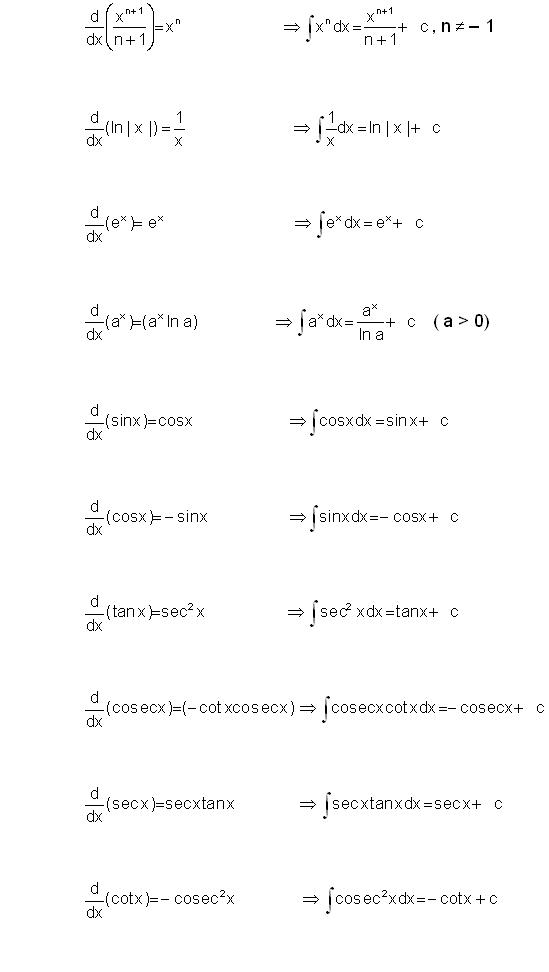Basic Concepts of Indefinite Integrals

 Let F(x) be a differentiable function of x such that d/dx [F(x)] = f(x). Then F(x) is called the integral of f(x). Symbolically, it is written as ∫ f(x) dx = F(x).
Let F(x) be a differentiable function of x such that d/dx [F(x)] = f(x). Then F(x) is called the integral of f(x). Symbolically, it is written as ∫ f(x) dx = F(x).
f(x), the function to be integrated, is called the integrand.
F(x) is also called the anti-derivative (or primitive function) of f(x).
As the differential coefficient of a constant is zero, we have
d/dx (F(x)) = f(x) ⇒ d/dx [F(x) + c] = f(x).
Therefore, ∫ f(x) dx = F(x) + c. This constant c is called the constant of integration and can take any real value.
|
|
Basic Formulae
Some of the important integrals of some frequently used functions are listed below:
|
Some Standard Formulae
|
Watch this Video for more reference
Example 1:
Evaluate ∫ 1/(1 + sin x) dx.
Solution:
In order to compute this integral, we multiply and divide it by (1-sin x) and so we have,
∫ 1/(1+ sin x) . (1 – sin x)/(1 - sin x) dx
= ∫ (1 – sin x)/(1 - sin2x) dx
= ∫ [(1 – sin x)/cos2x] dx
Now splitting it into two terms,
= ∫(1/cos2x dx – ∫ (sin x /cos2x) dx
= ∫ sec2x dx – ∫ tan x sec x dx
= tan x – sec x + c.
________________________________________________________________________________
Example 2:
Evaluate ∫ sin x /(1 + sin x) dx.
Solution:
∫ sin x /(1 + sin x) dx
= ∫ (sin x + 1 – 1)/(1 + sin x) dx
= ∫1 – ∫1/(1 + sin x) dx
= ∫1 – ∫(1 – sin x)/(1–sin2 x) dx
= ∫1 dx – ∫(1–sin x)/cos2 x dx
= ∫(1 – sec2 x + sec x tan x) dx
= x - tan x - sec x + C.
_____________________________________________________________________________
Example 3:
Evaluate ∫(sin3x + cos3x)/(sin2x cos2x) dx.
Solution:
![]()
= ∫ tan x sec x dx + ∫ cot x cosec x dx
= sec x – cosec x + c.
Methods of Integration
The following chart illustrates the various methods of integration:

These methods have been explained in detail in the coming sections. Students are advised to refer the coming sections to understand the concepts. Integration by substitution can further be divided into three parts:

It is better to memorize some of the standard substitutions as they often prove helpful in solving tricky questions.


Q1. Integration is the inverse process of
(a) the coefficient of x2.
(b) anti differentiation
(c) differentiation
(d) anti derivative
Q2. The answer of an indefinite integral
(a) necessarily has a constant
(b) may or may not have a constant
(c) cannot have a constant
(d) none of these
Q3. The differential coefficient of a constant is
(a) number itself
(b) zero
(c) constant
(d) none of these
Q4. If ∫ f(x) dx = F(x) + c, then
(a) F(x) is called the primitive function of f(x).
(b) f(x) is called the primitive function of F(x).
(c) F(x) is called the derivative function of f(x).
(d) f(x) is called the root of F(x).
Q5. While solving integrals of the form x2 + a2 or √(x2 + a2), the substitution used is
(a) x = a sec θ
(b) x = a tan θ
(c) x = a cosec θ
(d) x = a sin θ


|
Q1. |
Q2. |
Q3. |
Q4. |
Q5. |
|
(c) |
(a) |
(b) |
(a) |
(b) |
Related Resources
-
You may wish to refer Integration by Substitution.
-
Click here to refer the most Useful Books of Mathematics.
-
For getting an idea of the type of questions asked, refer the previous year papers.
To read more, Buy study materials of Indefinite integral comprising study notes, revision notes, video lectures, previous year solved questions etc. Also browse for more study materials on Mathematics here.



